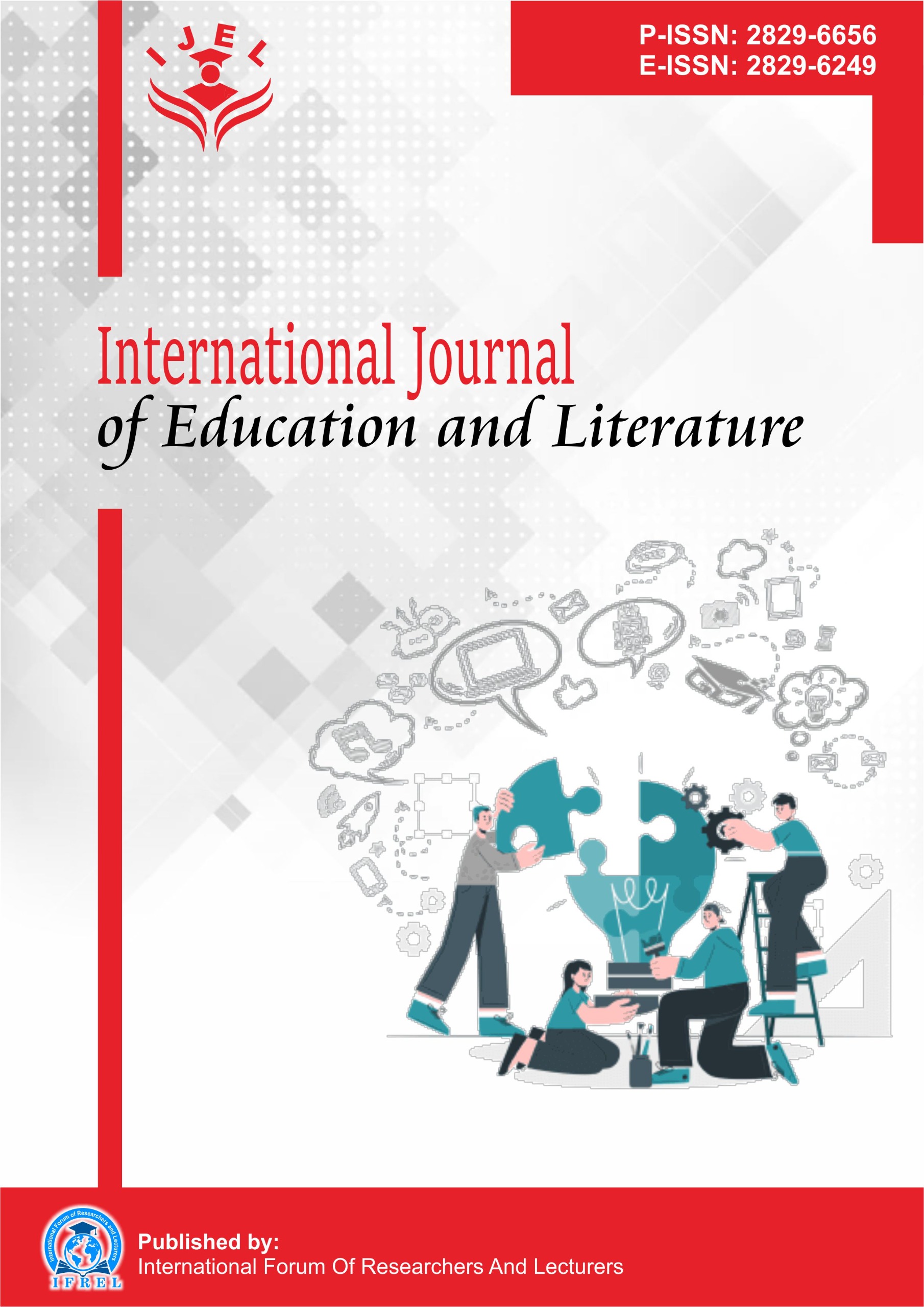Rapid Detection Method of GMO (Genetically Modified Organism) Content in Soybeans Using an Acid-Base Reaction Approach: A Physico-Chemical Experimental Study
DOI:
https://doi.org/10.55606/ijel.v4i2.269Keywords:
Acid–Base, GMO, Non-GMO, Physico-Chemical Detection, SoybeansAbstract
This study aimed to develop a simple acid-base reaction-based screening method for distinguishing between GMO (Genetically Modified Organism) and non-GMO soybeans as a practical alternative to expensive and expensive molecular methods. Twenty GMO soybean samples, 20 non-GMO samples, and three mixtures with ratios of 10%, 25%, and 50% were analyzed using 0.01–0.1 N HCl and 0.1 N NaOH solutions. Observation parameters included color change, pH, and absorbance using a UV-Vis spectrophotometer. The results showed that at a concentration of 0.01 N HCl, the color difference was most pronounced. The GMO sample solution showed a red color, while the non-GMO sample solution showed a green color. At higher concentrations, the differences became more subtle or difficult to distinguish. Validation using a PCR assay as the gold standard yielded sensitivity, specificity, and accuracy of >95%, indicating the reliability of this method as an initial screening technique. This physicochemical approach is considered effective for rapid, inexpensive, and easily implemented screening in food industry laboratories, particularly for monitoring non-GMO soybean raw materials and preventing food fraud. Therefore, this acid-base method has the potential to be a practical alternative solution for industry and education in detecting indications of GMOs before further confirmation with molecular methods.
References
Authors. (2005). Comparative studies of the quantification of genetically modified organisms in foods processed from maize and soy using trial producing. Journal of Agricultural and Food Chemistry, 53(6), 2060-2069. https://doi.org/10.1021/jf0483265
Broeders, S. R., De Keersmaecker, S. C., & Roosens, N. H. (2012). How to deal with the upcoming challenges in GMO detection in food and feed. TrAC Trends in Analytical Chemistry, 32(1), 100-111. https://doi.org/10.1155/2012/402418
Broeders, S., De Keersmaecker, S. C. J., & Roosens, N. H. (2014). How to deal with the upcoming challenges in GMO detection in food and feed. Journal of Biotech Research, 7, 14-22.
Compositional Variability in Conventional and Glyphosate-Tolerant Soybean…" (2011). Journal of Agricultural and Food Chemistry, 59(21), 11652-11656. https://doi.org/10.1021/jf202781v
Demeke, T., & Ratnasingham, A. (2019). Overview of GMO detection methods. Biotechnology Advances, 37(1), 107-124.
Detection and Quantification of Genetically Modified Soybean in Some Food and Feed Products: A Case Study on Products Available on Romanian Market. (2018). Sustainability, 10(5), 1325. https://doi.org/10.3390/su10051325
Equivalence Test between the Physicochemical Properties of Transgenic and Non-Transgenic Soy Flour. (2021). Plant Foods for Human Nutrition, 76, 473-482.
Fernando, I., Perera, R., & Seneviratne, L. (2024). Emerging technologies and systems to mitigate food fraud: A review and future directions. Critical Reviews in Food Science and Nutrition, 64(2), 215-231.
Fraiture, M. A., Herman, P., Taverniers, I., De Loose, M., Deforce, D., & Roosens, N. H. (2020). Current and future GM plant detection strategies. Trends in Food Science & Technology, 99, 25-35.
Friedman, M., & Brandon, D. L. (2001). Nutritional and health benefits of soy proteins. Journal of Agricultural and Food Chemistry, 49(3), https://doi.org/10.1021/jf0009246
Gwenzi, W. (2023). Chicanery in the food supply chain: Drivers, detection methods, and mitigation of food fraud. Journal of Environmental Chemical Engineering, 11(5), 110512.
Holst-Jensen, A., Bertheau, Y., de Loose, M., & Grohmann, L. (2012). Detecting unauthorized genetically modified organisms (GMOs) and derived materials. Biotechnology Advances, 30(6), 1318-1335. https://doi.org/10.1016/j.biotechadv.2012.01.024
Inothkanna, A., et al. (2024). Analytical technologies and chemometric tools in food fraud detection: A systematic review. Critical Reviews in Food Science and Nutrition, 64(3), 522-540.
Iu, K. (1997). Chemistry and nutritional value of soybean components. Soybeans: Chemistry, Technology, and Utilization, 1(1), 25-70. https://doi.org/10.1007/978-1-4615-1763-4_2
Li, X., Wang, D., et al. (2024). Origin traceability and adulteration detection of soybean using near infrared hyperspectral imaging. Food Frontiers, 5(2), 237-244. https://doi.org/10.1002/fft2.345
Monitoring and traceability of genetically modified soya bean event GTS 40-3-2 during soya bean protein concentrate and isolate preparation. Royal Society Open Science, 7, 201147. https://doi.org/10.1098/rsos.201147
Riaz, M. N. (2006). Physicochemical characteristics of soy protein ingredients. Journal of Food Science, 71(2), R138-R145.
Safaei, P., et al. (2019). Simple and accurate PCR method for detection of genetically modified rice: Principles applicable for GMO soy detection. Food Analytical Methods, 12(2), 465-472. https://doi.org/10.1007/s40201-019-00401-x
Shahidi, F. (2009). Spectrophotometric analysis in food chemistry: Principles and applications. Critical Reviews in Food Science and Nutrition, 49(3), 271-295.
Shrestha, H. K., & Cole, D. (2010). Advances in detection of genetically engineered crops by multiplex PCR and related methods. Trends in Analytical Chemistry, 29(7), 681-689.
Spink, J., & Moyer, D. C. (2011). Defining the public health threat of food fraud. Journal of Food Science, 76(9), R157-R163. https://doi.org/10.1111/j.1750-3841.2011.02417.x
Tiwari, B. K., & Singh, N. (2012). Pulse and legume processing: Physicochemical and functional properties. Food Research International, 49(1), 1-3.
van der Voet, H., Perry, J. N., Amzal, B., et al. (2011). A statistical assessment of differences and equivalences between genetically modified and reference plant varieties. BMC Biotechnology, 11, 15. https://doi.org/10.1186/1472-6750-11-15
Yimiao Xia, F., Chen, K., Liu, K., Zhang, L., Duan, X., Zhang, X., & Zhu, Z. (2019). Compositional differences between conventional Chinese and genetically modified Roundup Ready soybeans. Crop and Pasture Science, 70(6), 526-534. https://doi.org/10.1071/CP19006
Downloads
Published
How to Cite
Issue
Section
License
Copyright (c) 2025 International Journal of Education and Literature

This work is licensed under a Creative Commons Attribution-ShareAlike 4.0 International License.







